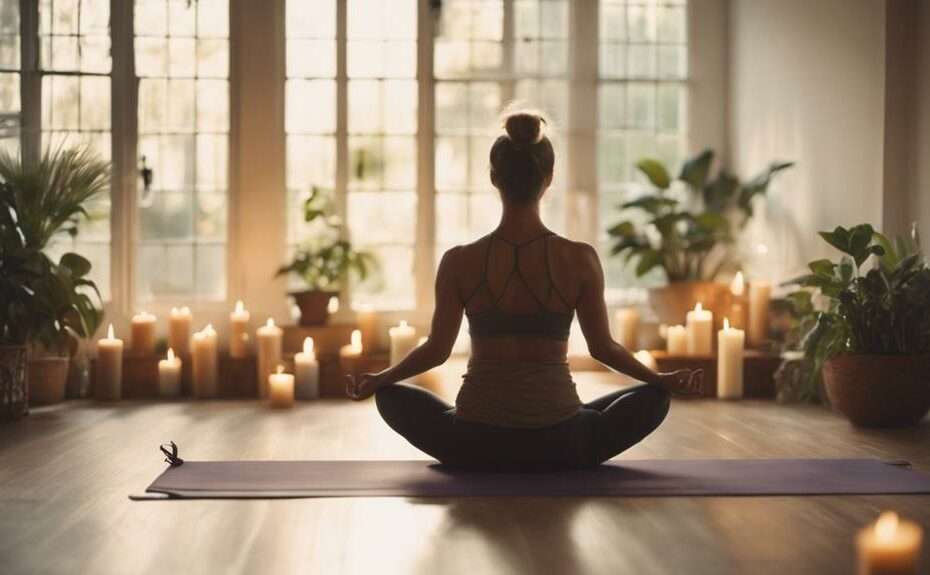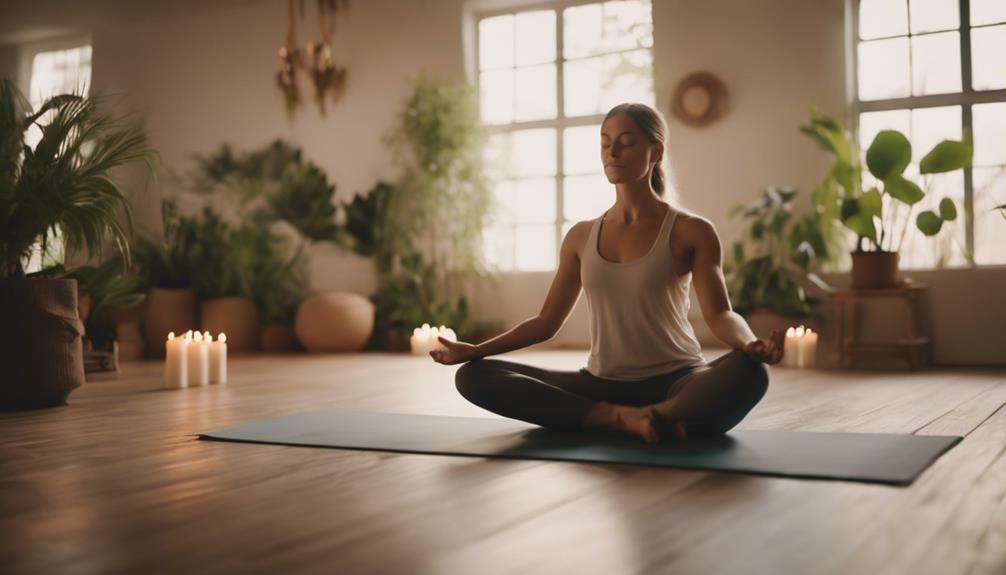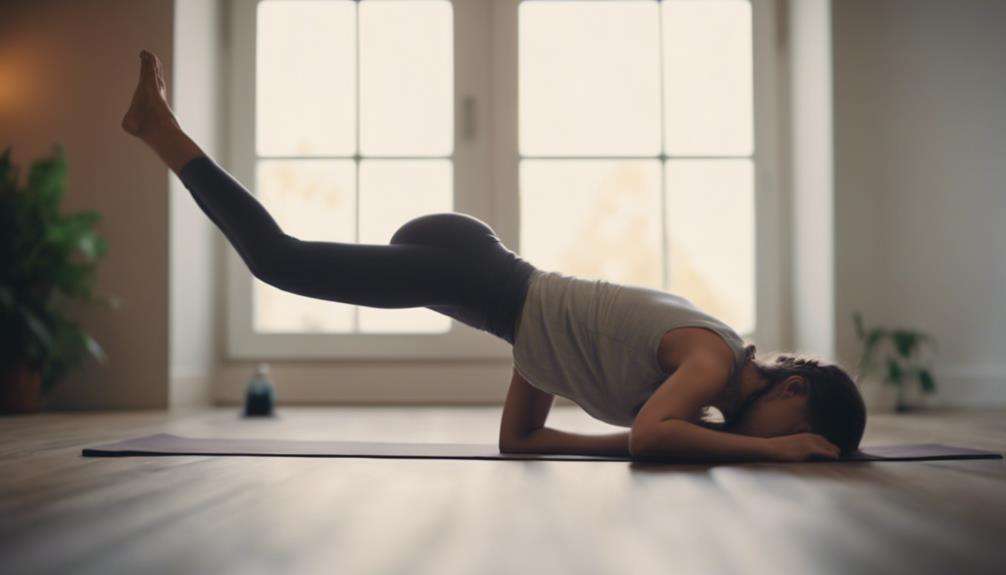When embarking on the journey of stress relief through yoga, envision a calm oasis where the mind finds solace and the body unwinds. By gently guiding yourself through each pose and connecting breath to movement, you can start a transformative process that nurtures not only your physical well-being but also your mental resilience.
The path to stress relief through yoga is not just about flexibility but about cultivating a harmonious balance within yourself that resonates throughout your daily life. So, why not take the first step towards a more tranquil existence and explore the serenity that awaits within the practice of yoga?
Key Takeaways
- Yoga poses and breathing techniques reduce stress levels effectively.
- Creating a calming yoga environment enhances stress relief during practice.
- Proper breathing techniques in yoga equip tools for stress management.
- Mindful meditation promotes mental clarity and inner peace for stress relief.
Benefits of Yoga for Stress Relief
Through yoga practice, you can experience a range of benefits that effectively reduce stress levels and promote overall well-being. Yoga offers a variety of poses and deep breathing techniques that help in inducing relaxation and decreasing stress. Specific yoga poses, such as child's pose, forward bends, and corpse pose, activate the body's relaxation response, calming the mind and reducing anxiety. Engaging in restorative yoga sessions can aid in releasing tension and promoting a sense of inner peace.
Mindfulness plays a crucial role in yoga practice, allowing you to stay present and focused on the current moment. By incorporating mindfulness into your yoga routine, you can improve your mental health and reduce stress levels significantly. The combination of physical postures, breathwork, and meditation in yoga offers a holistic approach to stress relief, enhancing your overall well-being. Regular practice of yoga not only helps in managing stress but also contributes to mental clarity and emotional stability. Embrace the benefits of yoga to cultivate a peaceful mind and a healthier body.
Understanding Stress Management Through Yoga
To effectively manage stress levels through yoga, a combination of poses, mindful breathing exercises, and meditation is utilized. Yoga serves as a powerful tool in stress management by targeting both the mind and body. The practice of yoga poses helps release tension stored in the muscles, promoting relaxation and reducing stress levels. By engaging in breathing exercises, such as deep diaphragmatic breathing and alternate nostril breathing, you can calm your mind and body, fostering a sense of inner peace. Creating a calming environment for your yoga practice further enhances the stress relief benefits, allowing you to fully immerse yourself in the present moment.
Proper alignment in yoga poses is crucial for beginners to ensure safe and effective stress management. As you embark on your yoga journey, focus on mastering basic poses with correct alignment to prevent injury and maximize the stress-relieving benefits of each posture. By incorporating these elements into your practice, you can develop a solid foundation for stress management through yoga.
Importance of Proper Breathing Techniques

Proper breathing techniques in yoga are foundational for activating the body's relaxation response and promoting stress relief. Techniques like diaphragmatic breathing engage the diaphragm, allowing for deeper breaths that help calm the nervous system.
Mindful breathing, a key aspect of yoga practice, assists in reducing stress hormones such as cortisol, fostering a sense of tranquility within. Deep breathing during yoga sessions enhances oxygen circulation in the body, which can aid in relaxation and sharpening focus.
By focusing on the breath, you establish a stronger mind-body connection, facilitating stress relief and mental clarity. Controlled breathing patterns incorporated in yoga help regulate emotions and lower anxiety levels effectively.
Embracing proper breathing techniques not only enriches your yoga practice but also equips you with valuable tools to manage stress and promote overall well-being.
Basic Yoga Poses for Stress Reduction
Enhance your stress relief practice with these fundamental yoga poses designed to promote relaxation and calmness.
Child's Pose, also known as Balasana, targets the back and shoulders, releasing tension and facilitating deep relaxation. By assuming this gentle pose, you can alleviate stress in these areas and foster a sense of tranquility.
Legs-Up-The-Wall Pose, or Viparita Karani, is effective in calming the nervous system and reducing overall stress levels. This pose involves lying on your back with your legs extended up against a wall, allowing gravity to help relax your body and calm the mind.
Corpse Pose, or Savasana, is the ultimate relaxation pose that promotes deep rest and rejuvenation.
Creating a Calming Yoga Environment
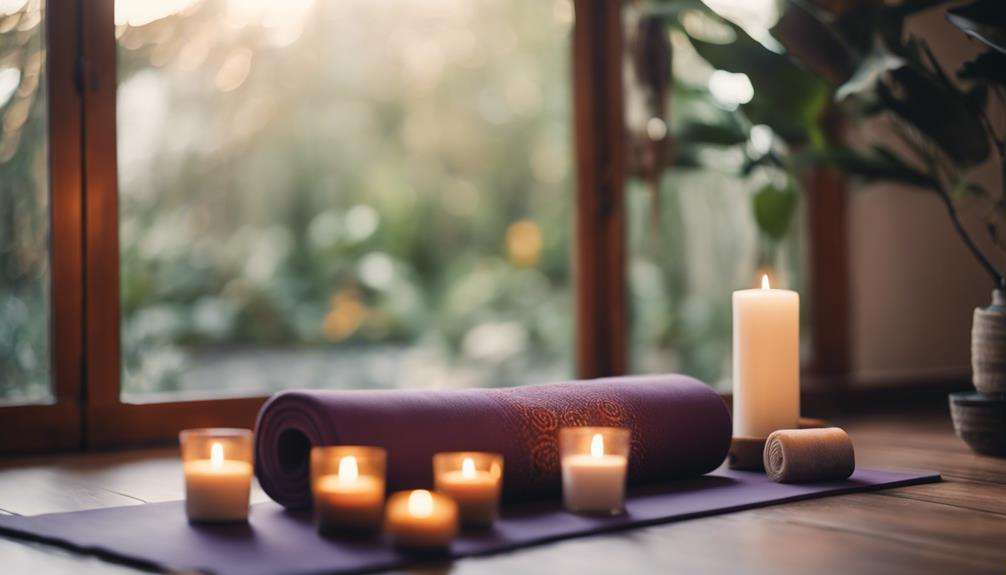
Create a serene and inviting space in your home dedicated to your yoga practice to facilitate peace and focus. Designate a quiet area free of clutter that promotes a restorative and relaxing environment. Incorporate elements like soft lighting, soothing music, or the use of essential oils to enhance the calming atmosphere. Proper ventilation and maintaining a comfortable temperature are essential for optimal stress relief during your practice.
To create a peaceful and calm ambiance, consider using calming colors and decor that resonate with you. By setting up a stress-free environment, you're laying the foundation for a more profound and meditative yoga session. A welcoming space will help you transition into a state of mindfulness more easily, allowing you to fully reap the benefits of your practice. Remember, the environment you create plays a crucial role in maximizing the stress-relieving effects of yoga.
Incorporating Meditation for Stress Relief
When it comes to managing stress through yoga, incorporating meditation techniques can greatly benefit your overall well-being.
By practicing mindful meditation, you can cultivate mental clarity, reduce anxiety, and promote a sense of inner peace.
Connecting your mind and body through meditation can improve focus, lower cortisol levels, and enhance emotional regulation.
Meditation Techniques
Mindfulness meditation, a powerful technique within yoga practice, serves as a valuable tool for reducing stress by fostering present-moment awareness.
Deep breathing exercises, commonly integrated into meditation, help calm the nervous system, decreasing stress hormones like cortisol.
Guided visualization techniques used during meditation sessions enhance relaxation and mental clarity, aiding in stress relief.
Mantra meditation, where a word or phrase is repeated to focus the mind, is another effective method for alleviating stress.
Regular practice of these meditation techniques can rewire the brain, reducing stress reactivity and promoting emotional well-being.
Mind-Body Connection
To deepen your understanding of stress relief within yoga practice, incorporating meditation techniques for fostering a strong mind-body connection is paramount.
Meditation plays a crucial role in enhancing stress relief by calming the mind and promoting relaxation. Through the mind-body connection established during meditation, you can experience a profound sense of inner peace and reduce anxiety levels effectively.
Regular practice of meditation not only helps in managing stress but also contributes to improving your overall well-being. Mindfulness techniques integrated into meditation assist in staying present and alleviating mental tension, leading to a state of calmness.
Establishing a Consistent Yoga Routine

Establishing a consistent yoga routine lays the foundation for harnessing the stress-relief benefits that yoga offers. By committing to a regular practice, you create a space for relaxation and inner peace amidst the chaos of daily life. Consistency is key in reaping the physical and mental rewards that yoga provides. When you incorporate yoga into your daily routine, you build resilience to stress, enhance flexibility, and strengthen both your body and mind.
A regular yoga practice not only helps in achieving balance but also fosters a sense of calmness that can positively impact your overall well-being. By dedicating time each day to practice yoga, you allow yourself the opportunity to unwind, release tension, and find moments of tranquility. This daily ritual can significantly reduce stress levels, promote relaxation, and create a sanctuary of peace within your busy schedule. Embrace the consistency of your yoga routine as a gift to yourself, nurturing both body and soul.
Exploring Different Yoga Styles for Wellness
When considering different yoga styles for your wellness journey, it's important to understand the unique benefits each one offers.
Restorative yoga can help you unwind and relax deeply, while Vinyasa yoga provides a more dynamic practice to enhance your strength and flexibility.
Whether you're a beginner or seeking a more traditional approach, exploring various yoga styles can enrich your overall well-being and stress relief efforts.
Yoga Styles Overview
Exploring different yoga styles for wellness allows individuals to find a practice that suits their physical, mental, and spiritual needs.
Restorative Yoga focuses on deep relaxation with passive poses, ideal for reducing stress.
Vinyasa Yoga offers flowing movements synchronized with breath, creating a dynamic practice.
Hatha Yoga combines asanas, breathwork, and meditation for overall well-being.
Kundalini Yoga incorporates dynamic movements, breath techniques, and chanting to awaken energy within.
Ashtanga Yoga follows a structured sequence to enhance strength, flexibility, and focus through disciplined practice.
Each style brings unique benefits, catering to various preferences and goals.
Experimenting with different yoga styles can help you discover the one that resonates best with your mind, body, and spirit for optimal wellness.
Benefits of Varieties
Discover the diverse benefits that different yoga styles offer for your overall wellness and stress relief.
Restorative yoga focuses on deep relaxation and healing, using passive poses with props to unwind tension.
Hatha yoga combines breathwork and asanas to enhance balance, strength, and mental clarity, aiding in stress reduction.
Vinyasa yoga emphasizes fluid movements synchronized with breath, promoting flexibility and releasing tension.
Yin yoga targets connective tissues through prolonged poses, enhancing flexibility and releasing stored stress in the body.
By exploring these varieties, you can find a practice that suits your needs, whether you seek relaxation, stress reduction, breathwork, or improved flexibility.
Embrace the diversity of yoga styles to support your well-being and cultivate a sense of calmness in your life.
Seeking Guidance for Yoga Practice
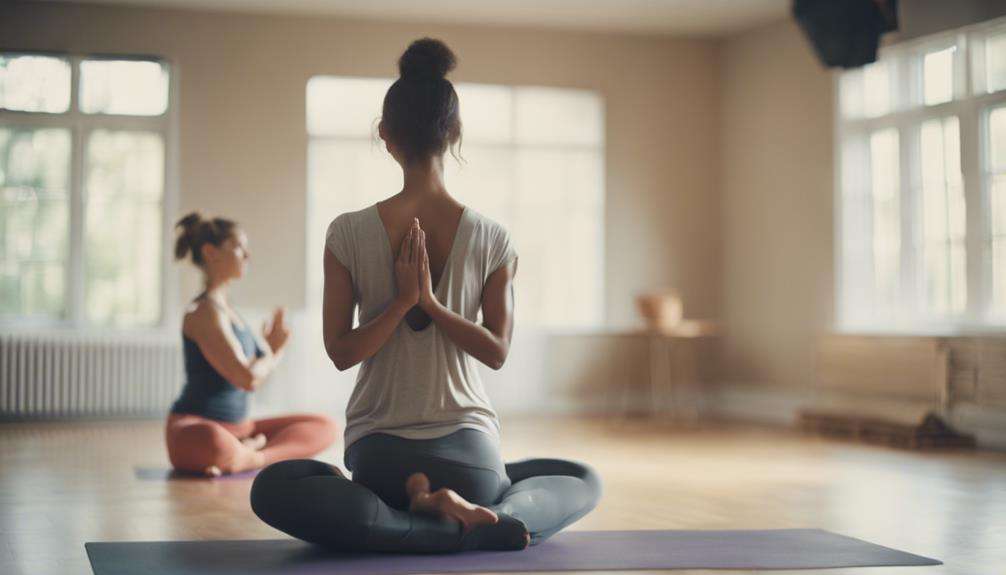
For personalized guidance on stress-relief yoga practices, consider consulting with a certified yoga instructor. They can offer tailored advice and assistance to help you effectively manage stress and anxiety through yoga.
Here are some key points to keep in mind as you seek guidance for your yoga practice:
- Join a Yoga Community: Being part of a yoga community can provide you with the support, motivation, and encouragement needed to integrate yoga into your stress management routine.
- Utilize Online Resources: Supplement your yoga practice with online tutorials, videos, and forums. These resources can enhance your practice and offer additional support outside of traditional classes.
- Explore Different Yoga Styles: Different yoga styles cater to various needs and preferences. By exploring these styles, you can find the right fit that best supports your stress relief journey.
Mind-Body Connection in Stress Reduction
Promoting a harmonious connection between your mind and body, yoga serves as a powerful tool for reducing stress and enhancing overall well-being. Through its integration of movement, breathwork, and meditation, yoga cultivates a strong mind-body connection that's essential for effective stress reduction. By practicing mindfulness during yoga sessions, you can enhance stress reduction by focusing on present moment awareness and letting go of distractions.
Breathwork plays a crucial role in regulating the nervous system, promoting relaxation, and fostering a sense of calmness. The breathing techniques employed in yoga help you manage stress by bringing attention to your breath and using it as a tool to anchor yourself in the present.
Yoga's emphasis on self-awareness and self-care practices further contributes to stress reduction. By engaging in yoga, you adopt a holistic approach to stress management that addresses both your mental and physical well-being. Embrace the mind-body connection in your yoga practice to experience profound benefits in stress reduction and overall wellness.
Frequently Asked Questions
What Type of Yoga Is Best for Stress Relief?
For stress relief, Restorative Yoga stands out. Its gentle, passive poses activate the parasympathetic nervous system, promoting calmness. Supported Childs Pose and Legs Up the Wall enhance relaxation. Incorporate it for inner peace and relaxation.
How to Stress Management Through Yoga?
To manage stress through yoga, focus on breathing techniques, relaxation poses, and meditation benefits. Strengthen your mind-body connection with yoga sequences that emphasize stress reduction. Deep breathing and mindfulness practices enhance your stress relief journey.
What Is the Best Yoga for Anxiety?
For anxiety relief, try restorative yoga. Relaxation poses, calming sequences, and grounding postures help reduce anxiety. Deep breathing, mindfulness, and meditation benefits promote inner peace. Embrace restorative yoga for effective anxiety reduction.
How Do I Start Yoga and Mindfulness?
To start yoga and mindfulness, begin with simple poses and mindful breathing. Relax with meditation and stress reduction techniques. Build a daily practice for mind-body connection. Consider a beginner's class or online resources for guidance.
Conclusion
You've taken the first step towards a more peaceful and relaxed life through yoga practice. Remember, the benefits of stress relief go beyond the physical – it's like a soothing balm for your mind and spirit.
Keep breathing deeply, moving mindfully, and creating your own tranquil space. Embrace the journey of self-care and find your inner calm amidst life's chaos.
You're on your way to a blissful oasis of serenity. Keep flowing with the rhythm of yoga.
